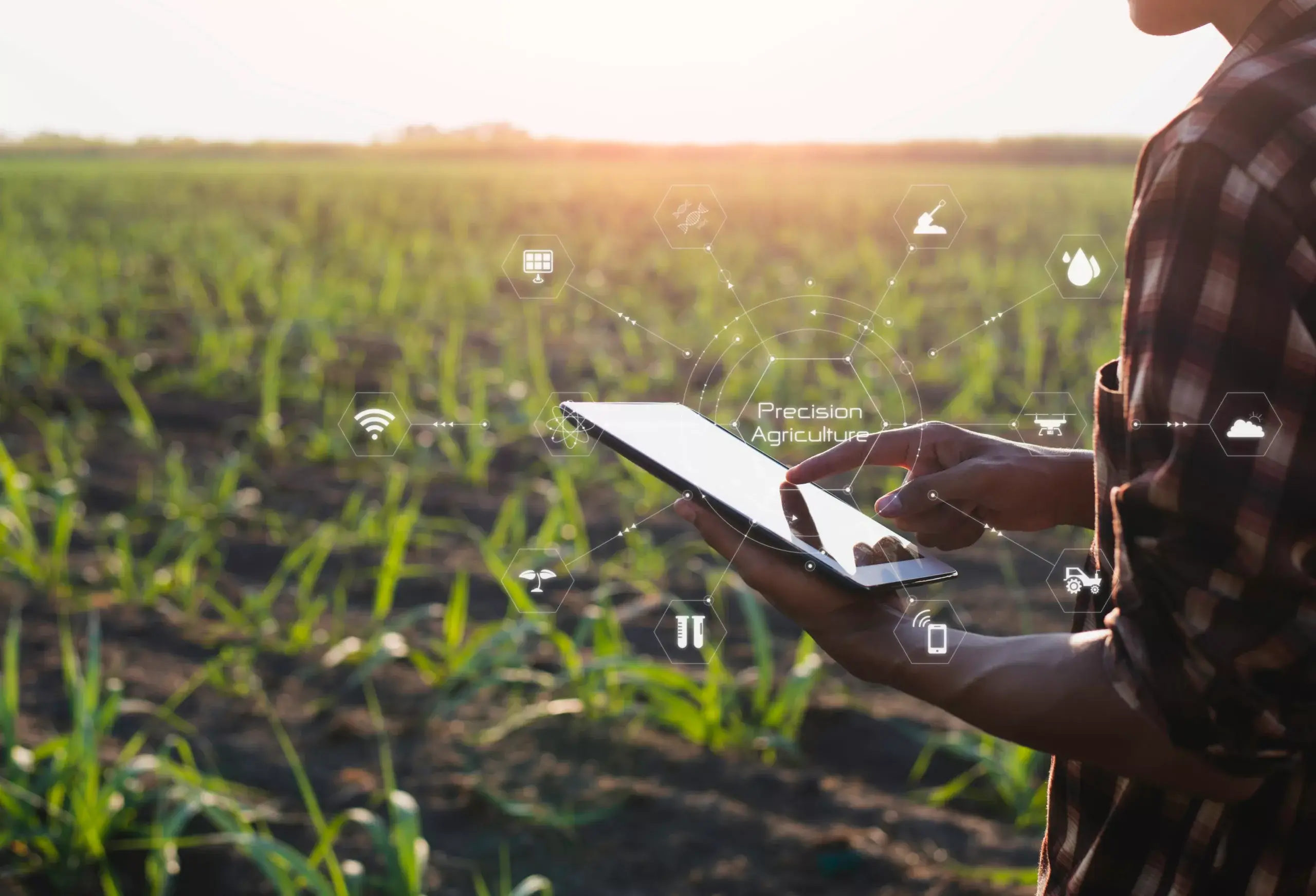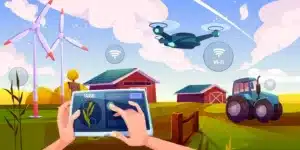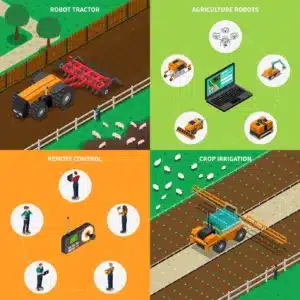Precision Agriculture: Accuracy promotes success

Table of Contents
Precision Agriculture (PA) is a farming methodology that uses data and technology to optimize input management, making farming more efficient and productive. This article shows how accuracy promotes success by presenting the different precision agriculture technologies, their applications, and their key benefits.
In the United States, advanced farming technologies are widely adopted. Over 25% of peanut farms use GPS soil mapping, and more than 40% use auto-steering. In rice farms, about 60% use yield monitoring technology, and approximately 55% use auto-guidance systems. In Europe, adoption is slightly lower for guidance technology, and variable rate technology for fertilizers (referring to adjusting inputs based on data analysis to tackle soil and crop variations) is lacking in many places (2021).
Several factors consistently have a positive influence, such as technology adoption, larger farms, formal education, farm ownership, sufficient financial resources, computer literacy, full-time farming, and field variations. On the other hand, a farmer’s age has a negative impact on technology adoption.
Precision farming involves various steps, including data collection on soil, crops, and yield, data analysis, applying specific treatments based on the analyzed data, recording and processing application data, and storing the data for future reference and analysis.

Precision agriculture technologies and applications
Technologies
Precision agriculture technologies have revolutionized modern farming practices, leveraging innovations such as GPS-guided tractors and drones for aerial imaging. These advancements enable farmers to optimize crop management, reduce resource waste, and enhance overall agricultural productivity. Key precision agriculture technologies include:
- GPS: Enables precise application of inputs based on location, avoiding waste and conserving water.
- Data Collection: Utilizes on-site sensors, satellites, drones, and weather stations to gather soil, crop, weather, and location data.
- Intra-field Diagnosis: Crop sensing and mapping aid in site-specific management decisions, optimizing resource usage.
- Automatic Variable-Rate Treatments: Ensure targeted resource application, meeting production and environmental goals.
- Global Navigation Satellite Systems (GNSS): Provide precise guidance and control for efficient field operations.
- Geospatial Technologies: Geographic Information System (GIS), remote sensing, and in situ; a type of sensing that is done close to the phenomena of interest, monitors crops, and aids decision-making.
- Remote Sensing: Uses aerial cameras to estimate soil properties, guiding better agricultural practices.
With the aid of the above technologies, precision agriculture optimizes resource usage, reduces environmental impact, and enhances productivity.
Applications
The technologies stated above are reflected in the following applications:
- Precision Input Management: Aims to optimize the use of crop inputs, reduce waste, and ensure environmental sustainability. Field machines equipped with Navigation Geographic Information Systems can collect high-resolution data for detailed crop management. Auto-steering Global Navigation Satellite System [GNSS]-controlled tractors minimize overlap, and map-driven seeding matches plant populations with soil conditions based on historical crop yield. Smart irrigation systems manage water usage in real-time, enhancing farm productivity and sustainability.
- Variable Rate Technology (VRT): Aims to apply inputs at variable rates based on data analysis to address soil and crop variations. VRT uses maps or sensors to adjust input concentrations during application. The adoption of VRT is growing rapidly, offering farmers more efficient and precise resource utilization.
- GPS Guidance Systems: This application implements GPS for precise navigation of agricultural machinery. Automated guidance systems relieve operators from continuous steering adjustments and reduce errors, fatigue, and environmental impact. Foam markers and parallel-tracking devices aid in navigation, while advanced auto-steer systems can automatically steer the vehicle.
- Yield Mapping: Creates maps displaying crop yield variations within fields. Modern combine harvesters are equipped with yield monitors, enabling farmers to assess crop performance and generate geo-referenced yield maps for comparisons and management decisions.
- Resource Conservation: The key objective is to minimize resource use and prevent environmental impact. Conservation Agriculture (CA) practices reduce input consumption and externalities. CA focuses on reducing soil erosion, water waste, and chemical runoff and promoting sustainable farming practices.

Precision agriculture holds significant importance
Precision agriculture offers various benefits, including healthier crops and increased production. By reducing the use of fertilizers, water, and pesticides, this technology enables proper crop management and maximizes land use. This is crucial given the current global situation, as agriculture faces immense pressure to meet the needs of a projected 10 billion people by 2050, requiring a 98% increase in food production. Additionally, agriculture accounts for over 70% of global freshwater use, with about half of it wasted. PA’s ability to reduce costs and environmental impact makes it an essential tool to address future challenges, especially in the context of the world’s climate crisis.
Southern Alberta illustrates this issue – the region, located in the Canadian province of Alberta, is home to the country’s largest irrigation farming system, accounting for 68% of all irrigated land in the country. It is renowned for its highly productive and fertile agricultural land, making it a significant agricultural area in Canada. Farmers in this region have widely adopted precision agriculture (PA) technologies. These technologies have consistently shown positive effects on agricultural sustainability, reducing the use of irrigation water, fertilizers, herbicides, and pesticides, leading to more sustainable farming practices. Cristopher and Lorraine Nicole’s study in the region shows reductions in farm inputs. Among the irrigation districts, the most significant percentage decline was observed in the utilization of irrigation water, with reductions ranging from 21% to 26%. Decreases in the application of fertilizers varied from 15% to 22%, herbicide use declined by 14% to 17%, and pesticide usage showed reductions from 13% to 20%.
Environmental benefits
Precision Agriculture (PA) is a key solution to the challenge of meeting the world’s growing food demand while ensuring environmental sustainability. PA uses data collection and advanced technologies to optimize farming efficiency and resource allocation. This leads to reduced inputs, lower costs, and increased profits for farmers, while also benefiting the environment by minimizing harmful run-off and conserving water. PA’s positive impact has garnered significant investment and is crucial in building a sustainable and efficient agricultural system for the future.
Economic benefits
Precision Agriculture is not only beneficial for the environment but also has significant social and economic implications. Smallholder farmers make up about 90% of farmers in many parts of the world; they represent a significant portion of the farming community and therefore play a vital role in ensuring food security.
However, they face challenges that hinder their sustainability and livelihoods. By adopting PA, these farmers can transform their farms into profitable and sustainable ventures. With increased productivity and better market access, they can improve their livelihoods and support their families. Not only would this lead to a better quality of life, but it would also contribute to food security by increasing the amount of food produced. PA offers a promising pathway to empower and uplift smallholder farmers, enabling them to thrive in the changing agricultural landscape.
The soybean challenge confronting American farmers offers a compelling illustration of how precision agriculture can potentially enhance yields and aid farmers in achieving financial sustainability. Soybeans are crucial for global food security, but the soybean cyst nematode (SCN) is causing significant grain loss in U.S. soybean yields, which contribute to 32% of global soybean planting. Despite advanced management techniques like crop rotation and resistant varieties, SCN remains a major disruptive pest. Early detection of SCN is difficult due to the lack of visible symptoms in soybean plants. Common soil sampling methods for SCN detection have issues, including unreliable threshold damage methods. To address these challenges, precision agriculture explores innovative approaches like deep learning and hyperspectral imaging for efficient and scalable plant disease detection, promising solutions to enhance soybean crop management.
The adoption of precision agriculture is influenced by farmers’ perceptions of its profitability and their ability to manage it effectively. Consultants and computer use also play a role in adoption, and support and training in using computers may be necessary for long-term success. In the future, farmers will need to acquire new skills and adopt a different mindset to keep up with changes in PA.
For precision agriculture to become more widespread, farmers need access to reliable and timely data to make better decisions about their crops and land. Collaboration between the public and private sectors is crucial to support and encourage its adoption.
Accuracy is a crucial factor for success in precision agriculture. The use of advanced technologies to collect precise data allows farmers to make informed decisions tailored to their fields’ specific needs. This precision optimizes resource usage, reduces waste, minimizes environmental impacts, and improves overall efficiency and productivity. Accurate data also aids in early problem identification and crop yield improvement. Additionally, precision data enhances the effectiveness of automated farming equipment like GPS-guided tractors and drones. Overall, accuracy in data collection and analysis leads to improved farm management, increased profitability, and sustainable agricultural practices.
References
https://www.intechopen.com/chapters/82490
https://www.mdpi.com/1996-1073/15/1/217
https://www.ers.usda.gov/publications/pub-details/?pubid=105893
https://www.tandfonline.com/doi/full/10.1080/09064710.2021.2024874
https://plantmethods.biomedcentral.com/articles/10.1186/s13007-022-00933-8